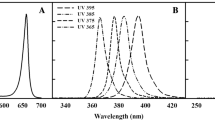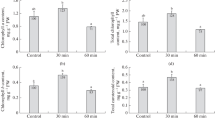Abstract
Effect of UV-B rays (280–320 nm) on photosynthetic electron transport and production of phenolic compounds in tea (Camellia sinensis L.) callus culture grown in white light was investigated. When white light was supplemented with UV radiation, the culture growth was retarded and morphological characteristics were modified. These conditions promoted the formation of chlorophyll-bearing cells and altered the ability of cultured cells to accumulate phenolic compounds, including flavans specific to Camellia sinensis. By the end of the culturing cycle (on the 45th day), the total content of phenolic compounds in the culture grown under supplementary UV irradiation was almost 1.5 times higher than in the control culture. The UV rays greatly stimulated photosystem II (PSII) activity in phototrophic cells of the callus culture, which was indicated by a large increase in the ratio of variable chlorophyll fluorescence to maximal fluorescence. This ratio was as low as 0.19 in cells cultured in white light and increased to 0.53 in the cell culture grown under white and UV light. The kinetics of dark relaxation of chlorophyll variable fluorescence, related to reoxidation of PSII primary acceptor, contained either two or three components, depending on the absence or presence of UV radiation, respectively. An artificial electron acceptor of PSI, methyl viologen modified the kinetics of dark decay of chlorophyll variable fluorescence in a characteristic manner, implying that photosynthetic electron transport was mediated by PSI and PSII in both treatments (culturing in white light with and without UV-B). It is concluded that stimulatory effect of UV rays on the parameters examined in phototrophic regions of Camellia tissue culture is determined by photoexcitation of a regulatory pigment that absorbs quanta in blue and long-wave UV spectral regions.
Similar content being viewed by others
Abbreviations
- PSI and PSII:
-
photosystems I and II
REFERENCES
Zaprometov, M.N., Fenol'nye soedineniya i ikh rol' v zhizni rasteniya (Phenolic Compounds and Their Role in Plant Life), Moscow: Nauka, 1996.
Zaprometov, M.N., Specialized Functions of Phenolic Compounds in Plants, Fiziol. Rast. (Moscow), 1993, vol. 40, pp. 921–931 (Russ. Plant Physiol., Engl. Transl., pp. 796–804).
Dixon, R.A. and Paiva, N.L., Stress-Induced Phenylpropanoid Metabolism, Plant Cell, 1995, vol. 7, pp. 1085–1097.
Lin, J., He, Y., Kuang, T., and Ceulemans, R., Lignification and Lignin Heterogeneity for Various Age Classes of Bamboo (Phyllostachys pubescens) Stems, Physiol. Plant., 2002, vol. 114, pp. 296–301.
Landry, L.G., Chaple, C.C., and Last, R.L., Arabidopsis Mutants Lacking Phenolic Sunscreens Exhibit Enhanced Ultraviolet-B Injury and Oxidative Damage, Plant Physiol., 1995, vol. 195, pp. 1159–1166.
Stapleton, A.E., Ultraviolet Radiation and Plants: Burning Questions, Plant Cell, 1992, vol. 4, pp. 1353–1358.
Shul'gin, I.A., Zabirov, R.G., Shcherbina, I.P., and Tolibekov, D.T., Role of Ultraviolet Radiation in Stem Structure and Productivity of Wheat from Mountain Regions, Biol. Nauki, 1990, no. 7, pp. 107–118.
Rakitina, T.Ya., Vlasov, P.V., Zhalilova, F.Kh., and Kefeli, V.I., Abscisic Acid and Ethylene in Mutants of Arabidopsis thaliana Differing in Their Resistance to Ultraviolet (UV-B) Radiation Stress, Fiziol. Rast. (Moscow), 1994, vol. 41, pp. 682–686 (Russ. J. Plant Physiol., Engl. Transl., pp. 599–603).
Nogues, S., Allen, D.J., Morison, J.I., and Baker, N.R., Ultraviolet-B Radiation Effects on Water Relations, Leaf Development, and Photosynthesis in Droughted Pea Plants, Plant Physiol., 1998, vol. 117, pp. 173–181.
Olsson, L.C., Veit, M., Weissenbock, G., and Bornman, J.F., Differential Flavonoid Response to Enhanced UV-B Radiation in Brassica napus, Phytochemistry, 1998, vol. 40, pp. 1021–1028.
Zaprometov, M.N., The Formation of Phenolic Compounds in Plant Cell and Tissue Cultures and Possibility of Its Regulation, Advances in Cell Culture, Maramorosh, K. and Sato, G.H., Eds., New York: Academic, 1989, vol. 7, pp. 201–215.
Stafford, A., Natural Products and Metabolites from Plants and Plant Tissue Cultures, Plant Cell and Tissue Culture, Stafford, A. and Warren, G., Eds., Milton: Open Univ. Press, 1991, pp. 124–162.
Dalton, C.C. and Peel, E., Product Formation and Cell Specialization: A Case Study of Photosynthetic Development in Plant Cell Cultures, Progr. Indian Microbiol., 1983, vol. 17, pp. 109–141.
Bukhov, N.G., Dynamic Light Regulation of Photosynthesis (A Review), Fiziol. Rast. (Moscow), 2004, vol. 51, pp. 825–837 (Russ. J. Plant Physiol., Engl. Transl., pp. 742–753).
Schreiber, U., Hormann, H., Neubauer, C., and Klughammer, C., Assessment of Photosystem II Photochemical Quantum Yield by Chlorophyll Fluorescence Quenching Analysis, Aust. J. Plant Physiol., 1995, vol. 22, pp. 209–220.
Govindjee, Sixty-Three Years since Kautsky: Chlorophyll a Fluorescence, Aust. J. Plant Physiol., 1995, vol. 22, pp. 131–160.
Karapetyan, N.V., Rakhimberdieva, M.G., Bukhov, N.G., and Gurjan, I., Characterization of Photosystems in Chlamydomonas reinhardtii Mutants Differing in Their Fluorescence Yield, Photosynthetica, 1980, vol. 14, pp. 132–138.
Krause, G.H. and Weis, E., Chlorophyll Fluorescence and Photosynthesis: The Basis, Annu. Rev. Plant Physiol. Plant Mol. Biol., 1991, vol. 42, pp. 313–349.
Voskresenskaya, N.P., Fotoregulyatornye aspekty metabolizma rastenii, 38-e Timiryazevskoe chtenie (Photoregulation of Plant Metabolism, the 38th Timiryazev Lecture), Moscow: Nauka, 1979.
Tevini, M., UV-Effects on Plants, Concepts in Photobiology: Photosynthesis and Photomorphogenesis, Singhal, C.S., et al., Eds., New Delhi: Narosa Publ. House, 1994, pp. 588–613.
Voskresenskaya, N.P., Drozdova, I.S., Moskalenko, A.A., Chetverikov, A.A., and Tsel'niker, Yu.L., Reconstruction of the Photosynthetic Apparatus under Long-Time Illumination with Red and Blue Light, Fiziol. Rast. (Moscow), 1982, vol. 29, pp. 447–455 (Sov. Plant Physiol., Engl. Transl.).
Bukhov, N.G., Light Intensity and Spectral Content: Effects on Initial Stages of Photosynthesis, Fiziol. Rast. (Moscow), 1987, vol. 34, pp. 748–757 (Sov. Plant Physiol., Engl. Transl.).
Bukhov, N.G., Drozdova, I.S., Bondar, V.V., and Mokronosov, A.T., Blue, Red and Blue Plus Red Light Control of Chlorophyll Content and CO2 Gas Exchange in Barley Leaves: Quantitative Description of the Effect of Light Quality and Fluence Rate, Physiol. Plant., 1992, vol. 85, pp. 632–638.
Koretskaya, T.F. and Zaprometov, M.N., Tissue Culture of Tea Plant (Camellia sinensis L.) as the Model for Investigation of Conditions for Phenolic Compounds Production, Fiziol. Rast. (Moscow), 1975, vol. 22, pp. 282–288 (Sov. Plant Physiol., Engl. Transl.).
Schreiber, U., Bilger, W., and Schliwa, U., Continuous Recording of Photochemical and Non-Photochemical Chlorophyll Fluorescence Quenching with a New Type of Modulation Fluorometer, Photosynth. Res., 1986, vol. 10, pp. 51–62.
Zaprometov, M.N., Phenolic Compounds and Methods of Their Investigation, Biokhimicheskie metody v fiziologii rastenii (Biochemical Methods in Plant Physiology), Pavlinova, O.A., Ed., Moscow: Nauka, 1971, pp. 185–197.
Strekova, V.Yu., Zagoskina, N.V., Subbotina, G.A., and Zaprometov, M.N., Effects of Long-Time Illumination on the Synthesis of Phenolic Compounds and on the Chloroplast Formation in Callus Tissues from Tea Plant, Fiziol. Rast. (Moscow), 1989, vol. 36, pp. 83–88 (Sov. Plant Physiol., Engl. Transl.).
Zagoskina, N.V., Usik, T.V., and Zaprometov, M.N., Effects of Light Duration on Phenolic Metabolism in Photomixotrophic Callus Culture from Tea Plant, Fiziol. Rast. (Moscow), 1990, vol. 37, pp. 1089–1095 (Sov. Plant Physiol., Engl. Transl.).
Zaprometov, M.N. and Zagoskina, N.V., One More Argument for Chloroplast Participation in Phenolic Compounds Biosynthesis, Fiziol. Rast. (Moscow), 1987, vol. 34, pp. 165–171 (Sov. Plant Physiol., Engl. Transl.).
Zaprometov, M.N. and Nikolaeva, T.N., Chloroplasts Isolated from Kidney Bean Leaves Are Capable of Phenolic Compound Biosynthesis, Fiziol. Rast. (Moscow), 2003, vol. 50, pp. 699–702 (Russ. J. Plant Physiol., Engl. Transl., pp. 623–626).
Bukhov, N.G., Mohanty, P., Rakhimberdieva, M.G., and Karapetyan, N.V., Analysis of Dark-Relaxation Kinetics of Variable Fluorescence in Intact Leaves, Planta, 1992, vol. 187, pp. 122–127.
Bukhov, N., Egorova, E., Krendeleva, T., Rubin, A., Wiese, C., and Heber, U., Relaxation of Variable Chlorophyll Fluorescence after Illumination of Dark-Adapted Barley Leaves as Influenced by the Redox States of Electon Carriers, Photosynth. Res., 2001, vol. 70, pp. 155–166.
Egorova, E.A., Bukhov, N.G., Krendeleva, T.E., and Rubin, A.B., Heterogeneity of the Process of Quinone Aceptor Reduction in Intact Barley Leaves, Dokl. Akad. Nauk, 2001, vol. 377, pp. 696–699.
Satoh, K., Fluorescence Induction and Activity of Ferredoxin-NADP+ Reductase in Bryopsis Chloroplasts, Biochim. Biophys. Acta, 1981, vol. 638, pp. 327–331.
Laisk, A., Siebke, K., Gerst, U., Eichelmann, H., Oja, V., and Heber, U., Oscillations in Photosynthesis Are Initiated and Supported by Imbalance in the Supply of ATP and NADPH to the Calvin Cycle, Planta, 1991, vol. 185, pp. 554–562.
Holfgrete, S., Backhausen, J.E., Kitzmann, C., and Scheibe, R., Regulation of Steady-State Photosynthesis in Isolated Intact Chloroplasts under Constant Light: Responses of Carbon Fluxes, Metabolite Pools and Enzyme-Activation States to Changes of Electron Pressure, Plant Cell Physiol., 1997, vol. 38, pp. 1207–1210.
Bukhov, N.G., Boucher, N., and Carpentier, R., Transformation of the Photoacoustic Signal after Treatment of Barley Leaves with Methylviologen or High Temperatures, Photochem. Photobiol., 1996, vol. 63, pp. 296–301.
Marphy, T.M., Hamilton, C.M., and Street, H.E., Strain of Rosa damascena Cultured Cells Resistant to Ultraviolet Light, Plant Physiol., 1979, vol. 64, pp. 936–941.
Zagoskina, N.V., Dubravina, G.A., Alyavina, A.K., and Goncharuk, E.A., Effect of Ultraviolet (UV-B) Radiation on the Formation and Localization of Phenolic Compounds in Tea Plant Callus Cultures, Fiziol. Rast. (Moscow), 2003, vol. 50, pp. 302–308 (Russ. J. Plant Physiol., Engl. Transl., pp. 270–275).
Zaprometov, M.N., Light-Regulated Secondary Metabolism in Plants, Fiziol. Rast. (Moscow), 1987, vol. 34, pp. 689–711 (Sov. Plant Physiol., Engl. Transl.).
Olsson, L.C., Veit, M., Weissenbock, G., and Bornman, J.F., Differential Flavonoid Response to Enhanced UV-B Radiation in Brassica napus, Phytochemistry, 1998, vol. 40, pp. 1021–1028.
Smolov, A.P., Kuznetsova, N.Yu., Oleinikova, T.A., and Moskalenko, A.A., Pigments and Pigment-Protein Complexes in Chloroplasts from Soybean Mixotrophic Callus: Effects of Ammonium and Diuron, Fiziol. Rast. (Moscow), 1998, vol. 45, pp. 653–658 (Russ. J. Plant Physiol., Engl. Transl., pp. 558–562).
Yamashita, T. and Butler, W.L., Inhibition of Chloroplasts by UV-Radiation and Heat-Treatment, Plant Physiol., 1968, vol. 43, pp. 2037–2040.
De Lucia, E.H., Day, T.A., and Vogelman, T.C., Ultraviolet-B and Visible Light Penetration into Needles of Two Species of Subalpine Coniferes during Foliar Development, Plant, Cell Environ., 1992, vol. 15, pp. 921–929.
Author information
Authors and Affiliations
Additional information
__________
Translated from Fiziologiya Rastenii, Vol. 52, No. 6, 2005, pp. 830–838.
Original Russian Text Copyright © 2005 by Zagoskina, Alyavina, Gladyshko, Lapshin, Egorova, Bukhov.
Rights and permissions
About this article
Cite this article
Zagoskina, N.V., Alyavina, A.K., Gladyshko, T.O. et al. Ultraviolet Rays Promote Development of Photosystem II Photochemical Activity and Accumulation of Phenolic Compounds in the Tea Callus Culture (Camellia sinensis). Russ J Plant Physiol 52, 731–739 (2005). https://doi.org/10.1007/s11183-005-0109-3
Received:
Issue Date:
DOI: https://doi.org/10.1007/s11183-005-0109-3




